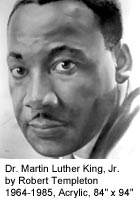Back to LEST WE FORGET IMAGES OF THE BLACK CIVIL RIGHTS MOVEMENT 2002 Exhibit Info
Foreward by the Director of HMA
|
FOREWORDBY ROBBIN ZELLA, Director, Housatonic Museum of Art |
 |
|
Terrorism. Unspeakable acts. Unthinkable events. These words explain recent events in New York and Washington, D.C. but less than 40 years ago, these same words could have been used to describe a tumultuous period in American history marked by murders, bombings, and riots. "The Sixties" was a time of immense political and social upheaval in this country - the struggle for Civil Rights, the Days of Rage, the anti-Vietnam War movement, the Women's Liberation movement and Gay Rights movement, and the emergence of a counterculture were periodically punctuated by assassinations: John F. Kennedy, Robert Kennedy, Medgar Evers, Malcolm X and Dr. Martin Luther King, Jr. Artist Robert Templeton witnessed the race riots in Detroit, the illustration of which appeared on the August 4, 1967 cover of Time magazine. Deeply disturbed by this event, Templeton resolved to create a pictorial civil rights history to commemorate its leaders for future generations. Lest We Forget: Images of the Black Civil Rights Movement is comprised of 34 portraits completed over the course of twenty years by this nationally known portraitist and includes key figures such as Dr. Martin Luther King, Jr., W.E.B. DuBois, Ralph Abernathy, Roy Wilkins, and Rosa Parks. But while Templeton focused his energy creating these timeless portraits, photographers such as Gordon Parks, Charles Moore and James Karales captured candid shots from the front lines of the movement. Searing images of police dogs attacking demonstrators, firemen hosing down protesters, King being arrested, and the march from Selma to Montgomery, distributed in newspapers around the country as well as in photo-essays in Look and Life magazines, served to speed the cause of civil rights. Reverend George Lee, Lamar Smith, Emmett Till, Willie Edwards, Jr., Louis Allen, Cpl. Ducksworth, Jr., and Viola Gregg Liuzzo are the ordinary heroes - black and white - memorialized in the film A Time For Justice. Produced by three-time Academy Award-winner Charles Guggenheim, this film is a moving account of the crises in Montgomery, Little Rock, Birmingham and Selma and is an homage to those who gave their lives for the cause of freedom and equality. Although the civil rights movement ended legal apartheid in this country and wrought significant changes in American life for African-Americans, women and other marginalized groups, it is nevertheless true that inequalities and racism remain, and so the struggle continues. I would like to thank the following people for their contributions to this exhibit: Leonore and Kevin Templeton for the loan of Robert Templeton's work; Parker Stephenson, Howard Greenberg Gallery, New York for assisting with the selection and loan of photographs, and Instructor Tony Ball for his comprehensive catalog essay. In addition, special thanks to Shelley Solomon, Assistant Principal at Hall High School in West Hartford and Professor Peter Ulisse for their contributions to educational programming; and to the Southern Poverty Law Center, the Parrish Art Museum, Southhampton, NY; and Bobs M. Tusa, Librarian, University of Southern Mississippi for assistance with research; Dr. James Mooney for educational panels, Helen Barnett for public relations and Blaine Kruger for design. Robbin Zella, Director, Housatonic Museum of Art Return to LEST WE FORGET exhibit home
|
|
